Report: Australian Migration Law, Refugee Programs, and Legislation
VerifiedAdded on 2022/09/28
|6
|1316
|20
Report
AI Summary
This report provides an overview of Australian migration law, focusing on the legal framework governing immigration and refugee protection. It examines key legislation, including the Migration Act 1958 and the Migration Regulations 1994, which outline visa subclasses and the processes for granting visas to non-citizens. The report details the Refugee and Humanitarian Program, differentiating between onshore protection for asylum seekers and offshore resettlement for refugees. It highlights Australia's participation in international conventions related to refugees and discusses the various categories within the offshore resettlement program, such as the Special Humanitarian Program and the Refugee Category. The report also addresses the welfare legislation and settlement services available to immigrants and refugees, emphasizing the evolution of these services in response to Australia's diverse population. It concludes by affirming Australia's commitment to protecting and assisting refugees and asylum seekers.
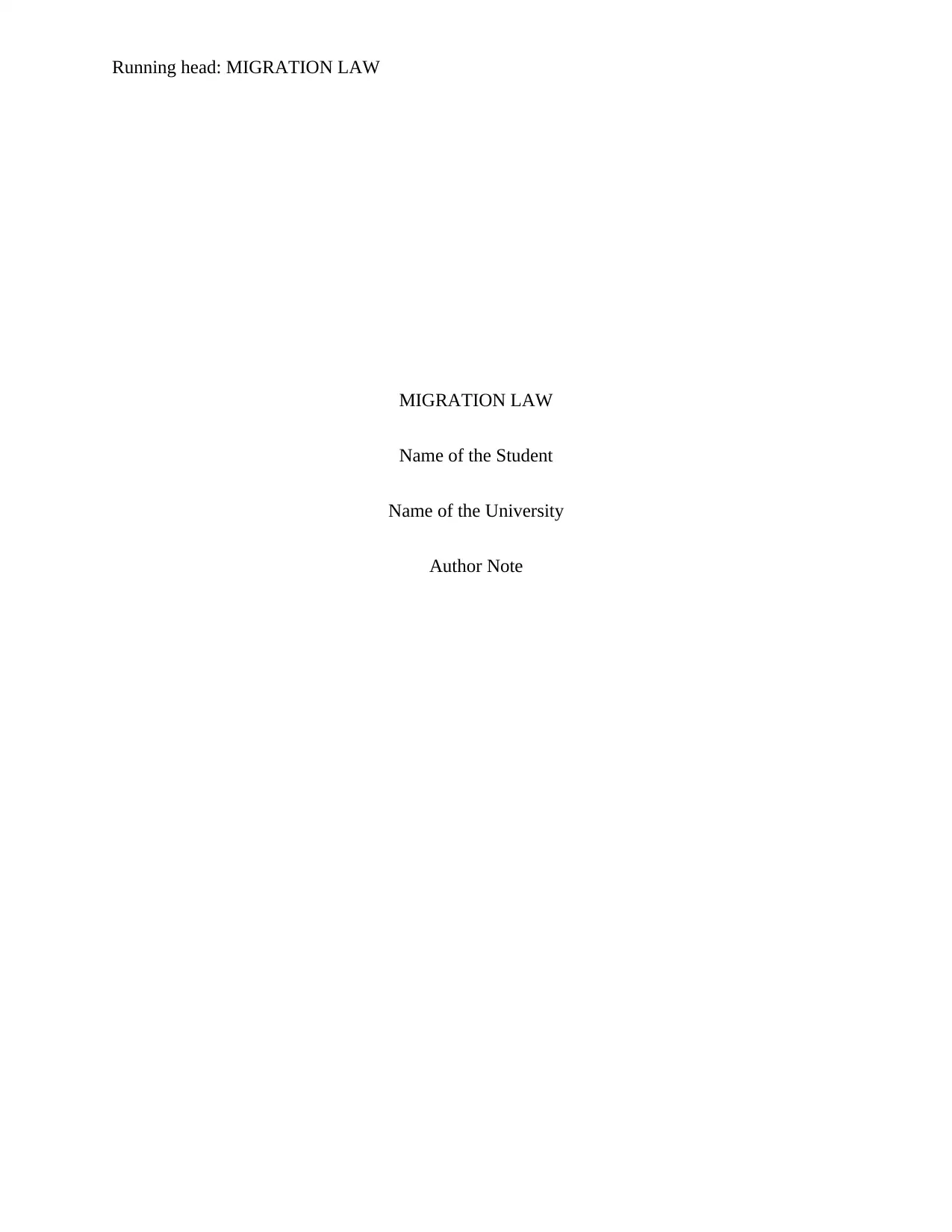
Running head: MIGRATION LAW
MIGRATION LAW
Name of the Student
Name of the University
Author Note
MIGRATION LAW
Name of the Student
Name of the University
Author Note
Paraphrase This Document
Need a fresh take? Get an instant paraphrase of this document with our AI Paraphraser
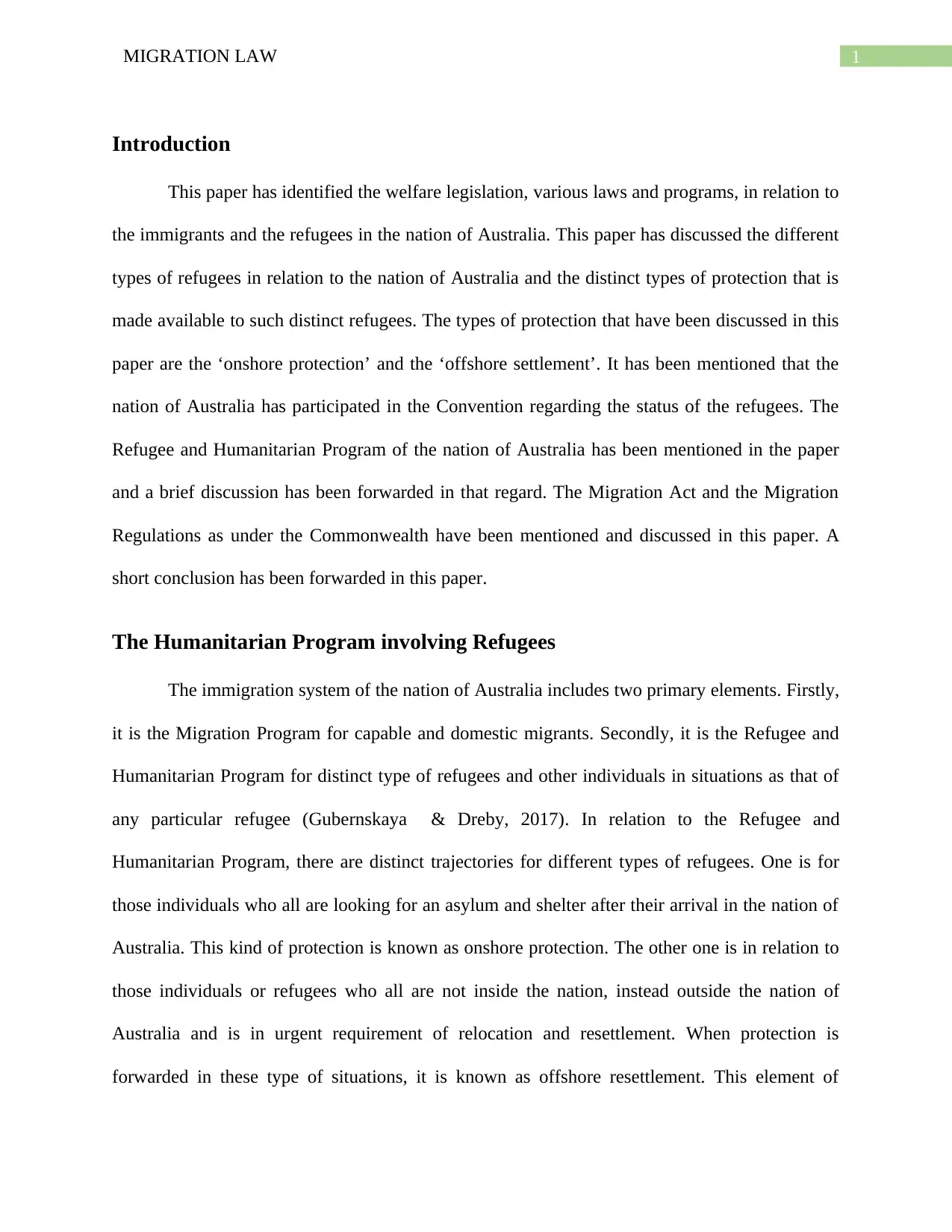
1MIGRATION LAW
Introduction
This paper has identified the welfare legislation, various laws and programs, in relation to
the immigrants and the refugees in the nation of Australia. This paper has discussed the different
types of refugees in relation to the nation of Australia and the distinct types of protection that is
made available to such distinct refugees. The types of protection that have been discussed in this
paper are the ‘onshore protection’ and the ‘offshore settlement’. It has been mentioned that the
nation of Australia has participated in the Convention regarding the status of the refugees. The
Refugee and Humanitarian Program of the nation of Australia has been mentioned in the paper
and a brief discussion has been forwarded in that regard. The Migration Act and the Migration
Regulations as under the Commonwealth have been mentioned and discussed in this paper. A
short conclusion has been forwarded in this paper.
The Humanitarian Program involving Refugees
The immigration system of the nation of Australia includes two primary elements. Firstly,
it is the Migration Program for capable and domestic migrants. Secondly, it is the Refugee and
Humanitarian Program for distinct type of refugees and other individuals in situations as that of
any particular refugee (Gubernskaya & Dreby, 2017). In relation to the Refugee and
Humanitarian Program, there are distinct trajectories for different types of refugees. One is for
those individuals who all are looking for an asylum and shelter after their arrival in the nation of
Australia. This kind of protection is known as onshore protection. The other one is in relation to
those individuals or refugees who all are not inside the nation, instead outside the nation of
Australia and is in urgent requirement of relocation and resettlement. When protection is
forwarded in these type of situations, it is known as offshore resettlement. This element of
Introduction
This paper has identified the welfare legislation, various laws and programs, in relation to
the immigrants and the refugees in the nation of Australia. This paper has discussed the different
types of refugees in relation to the nation of Australia and the distinct types of protection that is
made available to such distinct refugees. The types of protection that have been discussed in this
paper are the ‘onshore protection’ and the ‘offshore settlement’. It has been mentioned that the
nation of Australia has participated in the Convention regarding the status of the refugees. The
Refugee and Humanitarian Program of the nation of Australia has been mentioned in the paper
and a brief discussion has been forwarded in that regard. The Migration Act and the Migration
Regulations as under the Commonwealth have been mentioned and discussed in this paper. A
short conclusion has been forwarded in this paper.
The Humanitarian Program involving Refugees
The immigration system of the nation of Australia includes two primary elements. Firstly,
it is the Migration Program for capable and domestic migrants. Secondly, it is the Refugee and
Humanitarian Program for distinct type of refugees and other individuals in situations as that of
any particular refugee (Gubernskaya & Dreby, 2017). In relation to the Refugee and
Humanitarian Program, there are distinct trajectories for different types of refugees. One is for
those individuals who all are looking for an asylum and shelter after their arrival in the nation of
Australia. This kind of protection is known as onshore protection. The other one is in relation to
those individuals or refugees who all are not inside the nation, instead outside the nation of
Australia and is in urgent requirement of relocation and resettlement. When protection is
forwarded in these type of situations, it is known as offshore resettlement. This element of
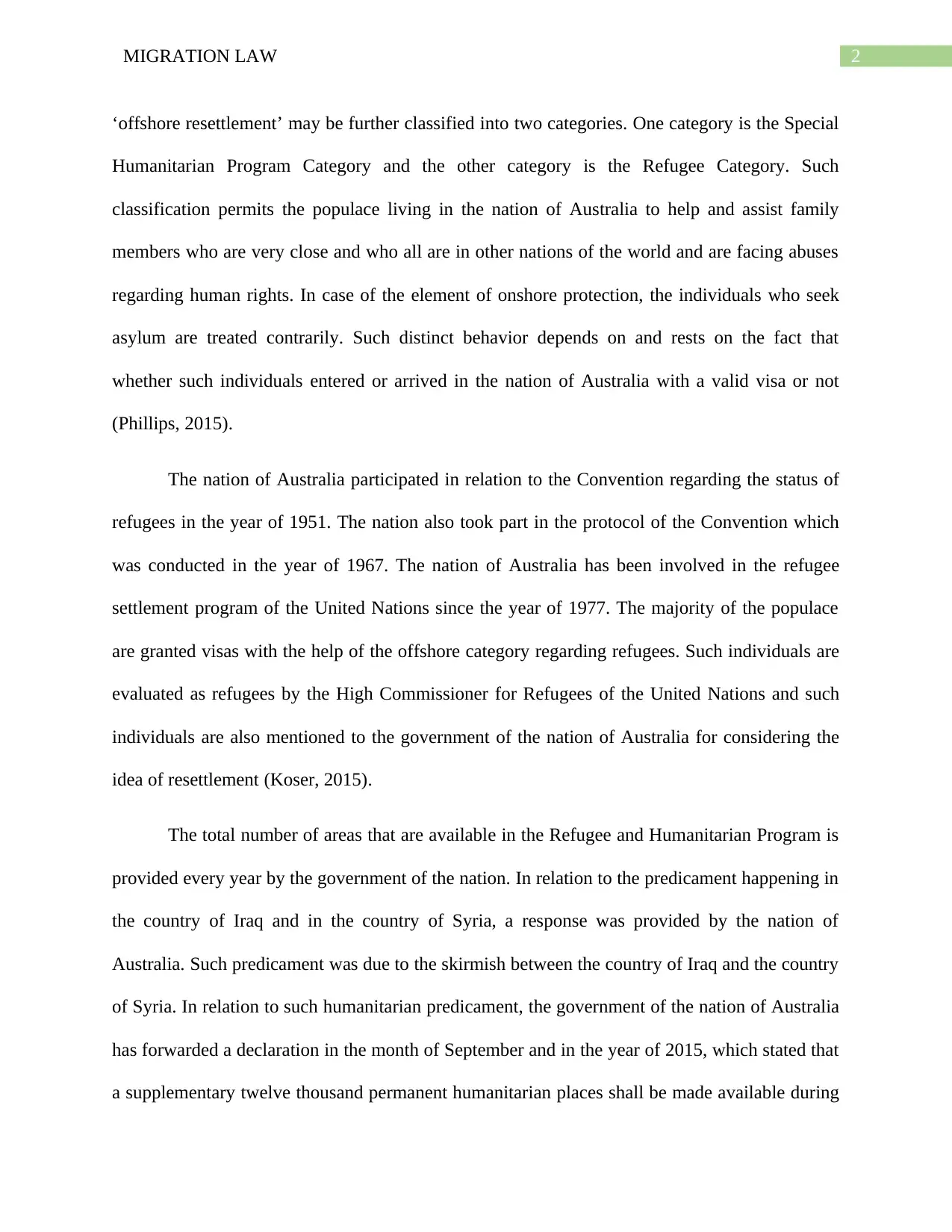
2MIGRATION LAW
‘offshore resettlement’ may be further classified into two categories. One category is the Special
Humanitarian Program Category and the other category is the Refugee Category. Such
classification permits the populace living in the nation of Australia to help and assist family
members who are very close and who all are in other nations of the world and are facing abuses
regarding human rights. In case of the element of onshore protection, the individuals who seek
asylum are treated contrarily. Such distinct behavior depends on and rests on the fact that
whether such individuals entered or arrived in the nation of Australia with a valid visa or not
(Phillips, 2015).
The nation of Australia participated in relation to the Convention regarding the status of
refugees in the year of 1951. The nation also took part in the protocol of the Convention which
was conducted in the year of 1967. The nation of Australia has been involved in the refugee
settlement program of the United Nations since the year of 1977. The majority of the populace
are granted visas with the help of the offshore category regarding refugees. Such individuals are
evaluated as refugees by the High Commissioner for Refugees of the United Nations and such
individuals are also mentioned to the government of the nation of Australia for considering the
idea of resettlement (Koser, 2015).
The total number of areas that are available in the Refugee and Humanitarian Program is
provided every year by the government of the nation. In relation to the predicament happening in
the country of Iraq and in the country of Syria, a response was provided by the nation of
Australia. Such predicament was due to the skirmish between the country of Iraq and the country
of Syria. In relation to such humanitarian predicament, the government of the nation of Australia
has forwarded a declaration in the month of September and in the year of 2015, which stated that
a supplementary twelve thousand permanent humanitarian places shall be made available during
‘offshore resettlement’ may be further classified into two categories. One category is the Special
Humanitarian Program Category and the other category is the Refugee Category. Such
classification permits the populace living in the nation of Australia to help and assist family
members who are very close and who all are in other nations of the world and are facing abuses
regarding human rights. In case of the element of onshore protection, the individuals who seek
asylum are treated contrarily. Such distinct behavior depends on and rests on the fact that
whether such individuals entered or arrived in the nation of Australia with a valid visa or not
(Phillips, 2015).
The nation of Australia participated in relation to the Convention regarding the status of
refugees in the year of 1951. The nation also took part in the protocol of the Convention which
was conducted in the year of 1967. The nation of Australia has been involved in the refugee
settlement program of the United Nations since the year of 1977. The majority of the populace
are granted visas with the help of the offshore category regarding refugees. Such individuals are
evaluated as refugees by the High Commissioner for Refugees of the United Nations and such
individuals are also mentioned to the government of the nation of Australia for considering the
idea of resettlement (Koser, 2015).
The total number of areas that are available in the Refugee and Humanitarian Program is
provided every year by the government of the nation. In relation to the predicament happening in
the country of Iraq and in the country of Syria, a response was provided by the nation of
Australia. Such predicament was due to the skirmish between the country of Iraq and the country
of Syria. In relation to such humanitarian predicament, the government of the nation of Australia
has forwarded a declaration in the month of September and in the year of 2015, which stated that
a supplementary twelve thousand permanent humanitarian places shall be made available during
⊘ This is a preview!⊘
Do you want full access?
Subscribe today to unlock all pages.

Trusted by 1+ million students worldwide
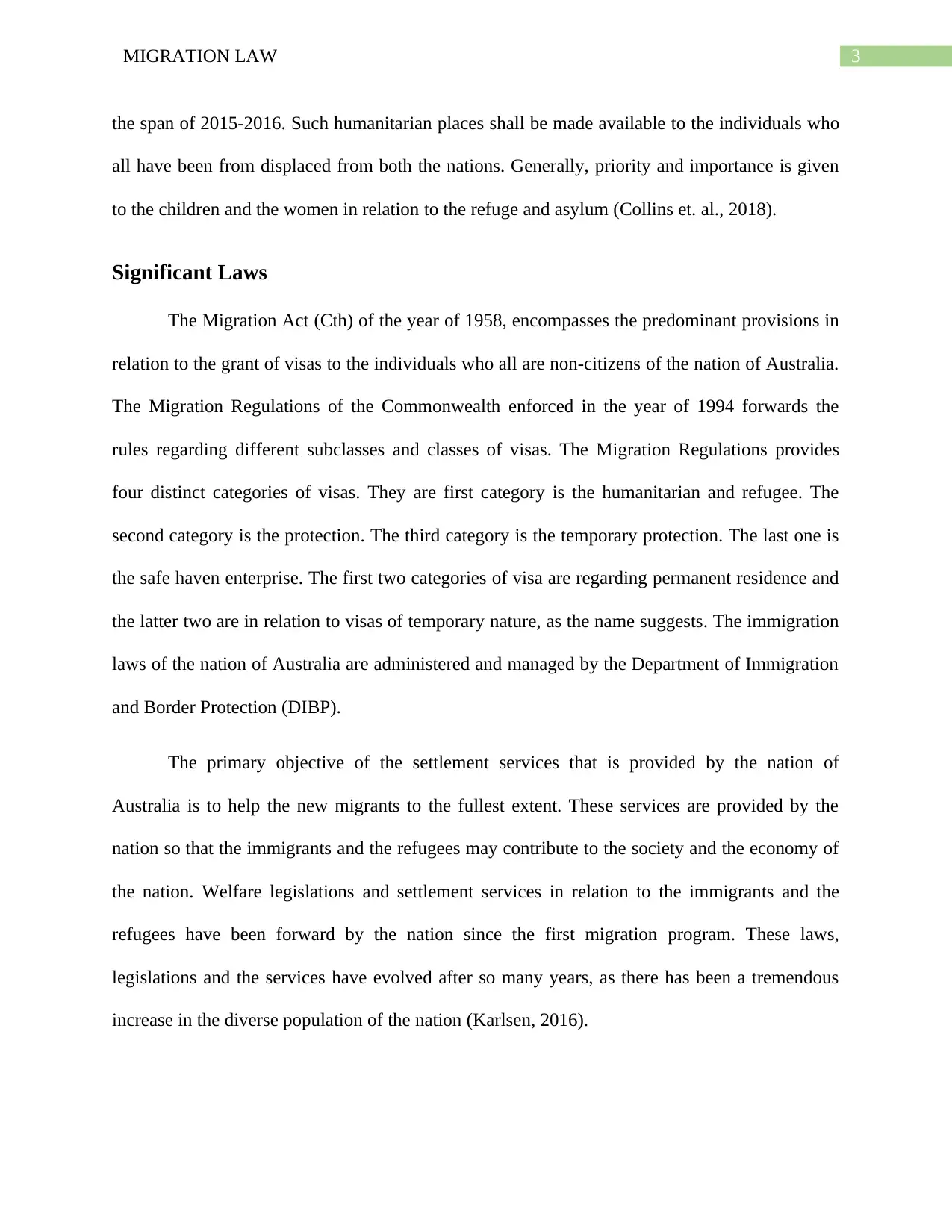
3MIGRATION LAW
the span of 2015-2016. Such humanitarian places shall be made available to the individuals who
all have been from displaced from both the nations. Generally, priority and importance is given
to the children and the women in relation to the refuge and asylum (Collins et. al., 2018).
Significant Laws
The Migration Act (Cth) of the year of 1958, encompasses the predominant provisions in
relation to the grant of visas to the individuals who all are non-citizens of the nation of Australia.
The Migration Regulations of the Commonwealth enforced in the year of 1994 forwards the
rules regarding different subclasses and classes of visas. The Migration Regulations provides
four distinct categories of visas. They are first category is the humanitarian and refugee. The
second category is the protection. The third category is the temporary protection. The last one is
the safe haven enterprise. The first two categories of visa are regarding permanent residence and
the latter two are in relation to visas of temporary nature, as the name suggests. The immigration
laws of the nation of Australia are administered and managed by the Department of Immigration
and Border Protection (DIBP).
The primary objective of the settlement services that is provided by the nation of
Australia is to help the new migrants to the fullest extent. These services are provided by the
nation so that the immigrants and the refugees may contribute to the society and the economy of
the nation. Welfare legislations and settlement services in relation to the immigrants and the
refugees have been forward by the nation since the first migration program. These laws,
legislations and the services have evolved after so many years, as there has been a tremendous
increase in the diverse population of the nation (Karlsen, 2016).
the span of 2015-2016. Such humanitarian places shall be made available to the individuals who
all have been from displaced from both the nations. Generally, priority and importance is given
to the children and the women in relation to the refuge and asylum (Collins et. al., 2018).
Significant Laws
The Migration Act (Cth) of the year of 1958, encompasses the predominant provisions in
relation to the grant of visas to the individuals who all are non-citizens of the nation of Australia.
The Migration Regulations of the Commonwealth enforced in the year of 1994 forwards the
rules regarding different subclasses and classes of visas. The Migration Regulations provides
four distinct categories of visas. They are first category is the humanitarian and refugee. The
second category is the protection. The third category is the temporary protection. The last one is
the safe haven enterprise. The first two categories of visa are regarding permanent residence and
the latter two are in relation to visas of temporary nature, as the name suggests. The immigration
laws of the nation of Australia are administered and managed by the Department of Immigration
and Border Protection (DIBP).
The primary objective of the settlement services that is provided by the nation of
Australia is to help the new migrants to the fullest extent. These services are provided by the
nation so that the immigrants and the refugees may contribute to the society and the economy of
the nation. Welfare legislations and settlement services in relation to the immigrants and the
refugees have been forward by the nation since the first migration program. These laws,
legislations and the services have evolved after so many years, as there has been a tremendous
increase in the diverse population of the nation (Karlsen, 2016).
Paraphrase This Document
Need a fresh take? Get an instant paraphrase of this document with our AI Paraphraser
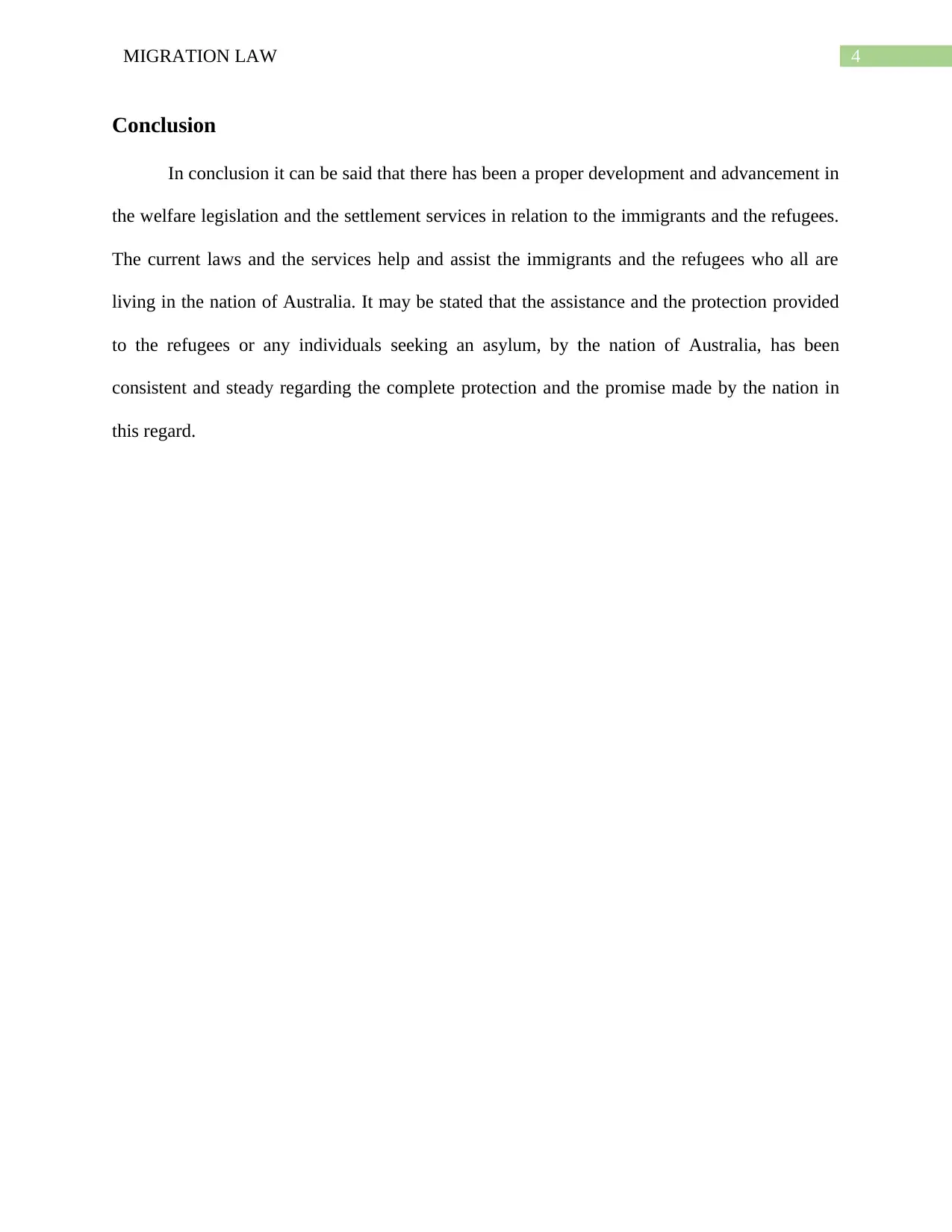
4MIGRATION LAW
Conclusion
In conclusion it can be said that there has been a proper development and advancement in
the welfare legislation and the settlement services in relation to the immigrants and the refugees.
The current laws and the services help and assist the immigrants and the refugees who all are
living in the nation of Australia. It may be stated that the assistance and the protection provided
to the refugees or any individuals seeking an asylum, by the nation of Australia, has been
consistent and steady regarding the complete protection and the promise made by the nation in
this regard.
Conclusion
In conclusion it can be said that there has been a proper development and advancement in
the welfare legislation and the settlement services in relation to the immigrants and the refugees.
The current laws and the services help and assist the immigrants and the refugees who all are
living in the nation of Australia. It may be stated that the assistance and the protection provided
to the refugees or any individuals seeking an asylum, by the nation of Australia, has been
consistent and steady regarding the complete protection and the promise made by the nation in
this regard.
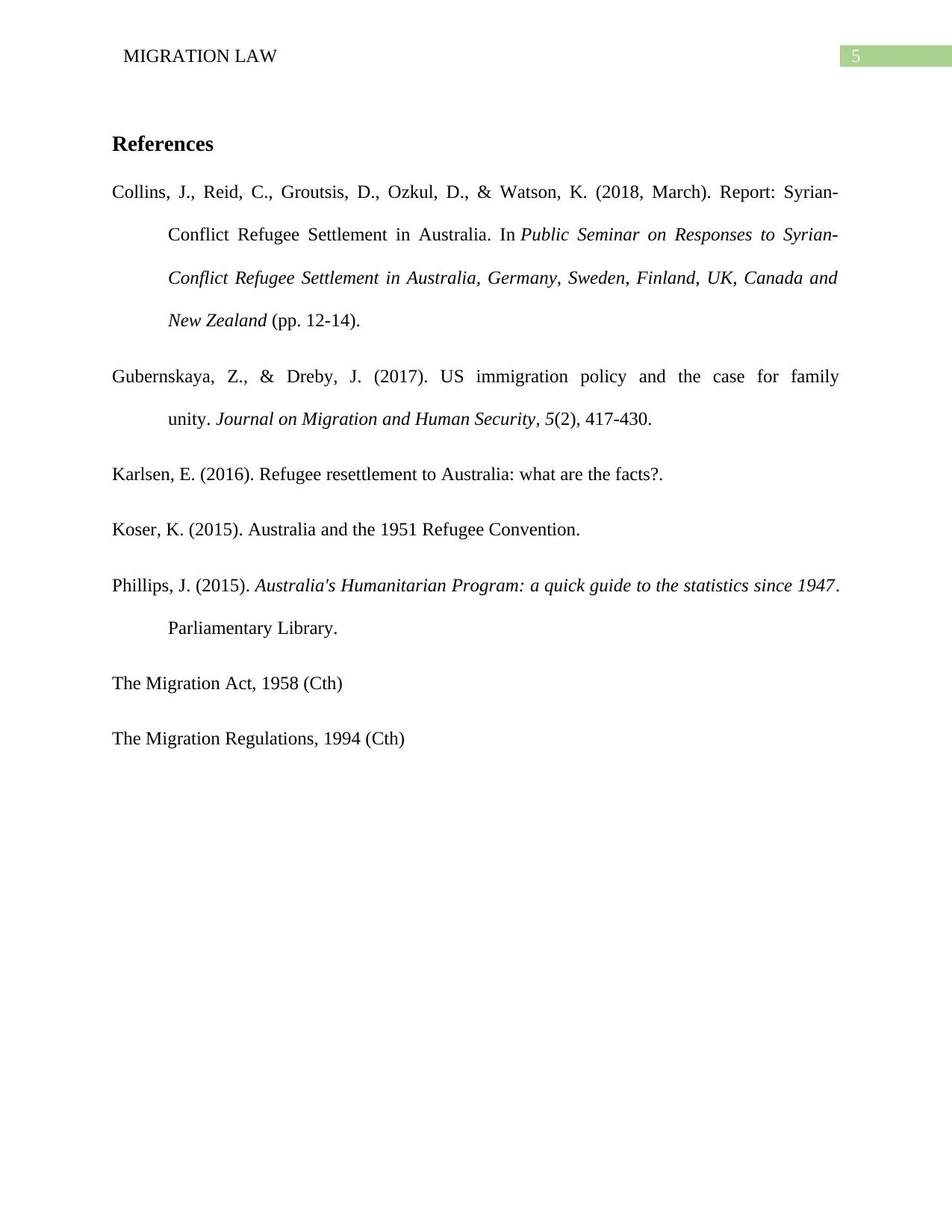
5MIGRATION LAW
References
Collins, J., Reid, C., Groutsis, D., Ozkul, D., & Watson, K. (2018, March). Report: Syrian-
Conflict Refugee Settlement in Australia. In Public Seminar on Responses to Syrian-
Conflict Refugee Settlement in Australia, Germany, Sweden, Finland, UK, Canada and
New Zealand (pp. 12-14).
Gubernskaya, Z., & Dreby, J. (2017). US immigration policy and the case for family
unity. Journal on Migration and Human Security, 5(2), 417-430.
Karlsen, E. (2016). Refugee resettlement to Australia: what are the facts?.
Koser, K. (2015). Australia and the 1951 Refugee Convention.
Phillips, J. (2015). Australia's Humanitarian Program: a quick guide to the statistics since 1947.
Parliamentary Library.
The Migration Act, 1958 (Cth)
The Migration Regulations, 1994 (Cth)
References
Collins, J., Reid, C., Groutsis, D., Ozkul, D., & Watson, K. (2018, March). Report: Syrian-
Conflict Refugee Settlement in Australia. In Public Seminar on Responses to Syrian-
Conflict Refugee Settlement in Australia, Germany, Sweden, Finland, UK, Canada and
New Zealand (pp. 12-14).
Gubernskaya, Z., & Dreby, J. (2017). US immigration policy and the case for family
unity. Journal on Migration and Human Security, 5(2), 417-430.
Karlsen, E. (2016). Refugee resettlement to Australia: what are the facts?.
Koser, K. (2015). Australia and the 1951 Refugee Convention.
Phillips, J. (2015). Australia's Humanitarian Program: a quick guide to the statistics since 1947.
Parliamentary Library.
The Migration Act, 1958 (Cth)
The Migration Regulations, 1994 (Cth)
⊘ This is a preview!⊘
Do you want full access?
Subscribe today to unlock all pages.

Trusted by 1+ million students worldwide
1 out of 6
Related Documents
Your All-in-One AI-Powered Toolkit for Academic Success.
+13062052269
info@desklib.com
Available 24*7 on WhatsApp / Email
![[object Object]](/_next/static/media/star-bottom.7253800d.svg)
Unlock your academic potential
Copyright © 2020–2025 A2Z Services. All Rights Reserved. Developed and managed by ZUCOL.





